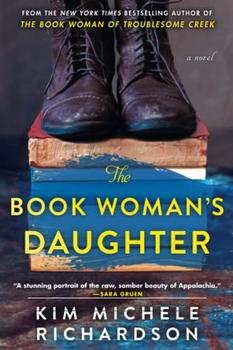Page 1 of 1
There are currently 2 reader reviews for The Book Woman's Daughter
Write your own review!
BuffaloGirlKS
Resonated with Me
I have a personal rating system I call the 4Es. Does the book engage my interest, educate and/or enlighten me, entertain me, and reach me emotionally? Very few books hit all four components. The Book Woman's Daughter did in spades. The characters were believable and well developed. The storyline was strong and well thought out. The descriptions of the geography, climate, and culture were perfect. As a reader, I felt I was there.
My maternal great grandparents came to Kansas from Hawkins County and Greene County, Tennessee in 1878. Greene County and Hawkins County are in Appalachia bordering Virginia and North Carolina respectively. My mother, aunt, and grandmother (Granny) brought my sister, my cousins, and me up on stories of our ancestors before, during, and after the Civil War and before and after their move to Kansas. Ms Richardson's writing resonated with me. I recommend this book to anyone who enjoys historical fiction or learning about other parts of the USA.
Djcminor
An Excellent Story
After reading The Book Woman of Troublesome Creek by Kim Michele Richardson, I could not recommend the book to enough people. I chose it for two book clubs to which I belong. Everyone I know who has read the book has thoroughly enjoyed it, learned from it, and recommended it to others. When I learned that Richardson was writing a sequel, The Book Woman’s Daughter, I couldn’t wait to read it. I attended a virtual event featuring Kim Michele Richardson through Adventures by the Book; along with my ticket, I received a copy of The Book Woman’s Daughter as soon as it was published.
The Book Woman’s Daughter can certainly be read as a standalone novel. I do think, however, that those who have also read The Book Woman of Troublesome Creek will find a deeper, richer connection to the story.
When The Book Woman’s Daughter opens in 1953, Honey Mary-Angeline Lovett is almost 17. Her parents are being arrested for breaking the laws of KY. Honey’s father Jackson had dared “to marry a woman of mixed color – a blue-skinned Kentuckian.” Cussy Lovett, Honey’s mother, has a condition called methemoglobinemia, a “gene disorder that the ol’ doc over in Troublesome Creek said me Honey and Mama and the Moffits had.” Cussy has quite blue skin all over, but Honey’s disorder manifests itself in her hands and feet and only when she is stressed or agitated.
As a minor and with her parents jailed, Honey could be sent to an orphanage until she is 18 or she could be remanded to the Kentucky House of Reform where she would be held until she was 21. She would be shackled and forced to do hard labor. And for what? Because the laws of KY were so antiquated and outdated! Her great fear is that the latter will be her fate if she cannot get to Troublesome Creek where a judge can name Retta Adams, 90, her guardian while her parents are in prison.
Honey, like Cussy, loves books. When she gets to Troublesome Creek, she sees an advertisement for a librarian to take books into the KY hills to isolated people just as her mother had done years before. Honey feels if she can get the job that will show she is capable of taking care of herself and she can contribute living expenses with Retta.
This story takes place in 1953, but it might as well be 1900. People in towns have electricity, indoor bathrooms, and running water. People living deep in the hills of KY still have wood stoves for heating and cooking. They have well water and use coal oil lamps. Honey herself has to learn how to use a public telephone. She hasn’t seen a television and hardly knows what a radio is.
Needless to say, Honey encounters a number obstacles in her path, but she also has friends who come to her aid. Her own ingenuity and innate intelligence serve her well too. I highly recommend The Book Woman’s Daughter. It will make readers angry, make them laugh, and ultimately provide them with an excellent story. For book clubs, the topics for discussion are almost endless: interracial marriage laws, child marriages, child emancipation, and child prison labor camps. Other topics will include the stories from the Pack Horse Library Project and the ingenuity of the librarians who took materials to families buried deep in the hills of KY.
